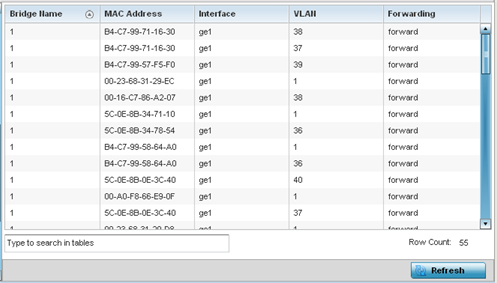AP Network Bridge
Bridging is a forwarding technique making no assumption about where a particular network address is located. It depends on flooding and the examination of source addresses in received packet headers to locate unknown devices. Once a device is located, its location is stored in a table to avoid broadcasting to that device again. Bridging is limited by its dependency on flooding, and is used in local area networks only. A bridge and a controller are very similar, since a controller is a bridge with a number of ports.
The Bridge screen provides details about the IGS (Integrate Gateway Server ), which is a router connected to an access point. The IGS performs the following:
- Issues IP addresses
- Throttles bandwidth
- Permits access to other networks
- Times out old logins
This screen also provides information about the MRouter (Multicast Router), which is a router program that distinguishes between multicast and unicast packets and how they should be distributed along the Multicast Internet. Using an appropriate algorithm, a multicast router instructs a switching device what to do with the multicast packet.
To view an access point's Bridge statistics:
- Select the Statistics menu from the Web UI.
- Expand the System node from the navigation pane (on the left-hand side of the screen). The System node expands to display the RF Domains created within the managed network.
- Expand an RF Domain node, select a controller or service platform, and select one of its connected access points. The access point's statistics menu displays in the right-hand side of the screen, with the Health tab selected by default.
- Expand the Network menu from the left-hand side of the UI.
- Select Bridge.The stats is displayed in the right-hand pane.
 This screen displays the following:
This screen displays the following:Bridge Name Displays the numeric ID of the network bridge. MAC Address Displays the MAC address (factory encoded hardware identifier) of the bridge. Interface Displays the interface (access point physical port name) where the bridge transferred packets. Supported access points models have different port configurations. VLAN Displays the VLAN the bridge is using as a virtual interface within the network. Forwarding Displays whether the bridge is forwarding packets and is in a forwarding state. A bridge can only forward packets. - Select Refresh to update the counters to their latest values.

